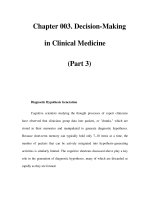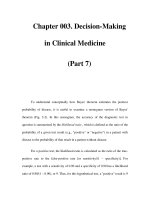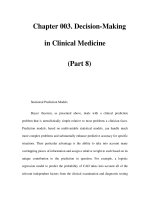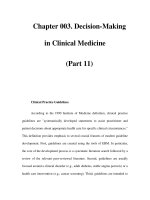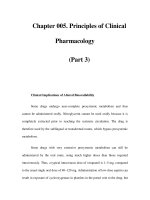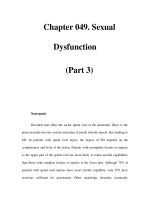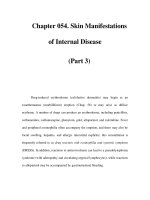Chapter 132. Infections Caused by Listeria monocytogenes (Part 3) docx
Bạn đang xem bản rút gọn của tài liệu. Xem và tải ngay bản đầy đủ của tài liệu tại đây (18.68 KB, 6 trang )
Chapter 132. Infections Caused by
Listeria monocytogenes
(Part 3)
Meningitis
L. monocytogenes causes ~5–10% of all cases of community-acquired
bacterial meningitis in adults in the United States. Case-fatality rates are reported
to be 15–26% and do not appear to have changed over time. This diagnosis should
be considered in all older or chronically ill adults with "aseptic" meningitis. The
presentation is more frequently subacute (with illness developing over several
days) than in meningitis of other bacterial etiologies, and nuchal rigidity and
meningeal signs are less common. Photophobia is infrequent. Focal findings and
seizures are common in some but not all series. The CSF profile in listerial
meningitis most often shows white blood cell (WBC) counts in the range of 100–
5000/µL (rarely higher); 75% of patients have WBC counts below 1000/µL,
usually with a neutrophil predominance more modest than that in other bacterial
meningitides. Low glucose levels and positive results on Gram's staining are found
~30–40% of the time.
Meningoencephalitis and Focal CNS Infection
L. monocytogenes can directly invade the brain parenchyma, producing
either cerebritis or focal abscess. Approximately 10% of cases of CNS infection
are macroscopic abscesses resulting from bacteremic seeding; the affected patients
often have positive blood cultures. Concurrent meningitis can exist, but the CSF
may appear normal. Abscesses can be misdiagnosed as metastatic or primary
tumors and, in rare instances, occur in the cerebellum and the spinal cord. Invasion
of the brainstem results in a characteristic severe rhombencephalitis, usually in
otherwise healthy older adults. The presentation may be biphasic, with a prodrome
of fever and headache followed by asymmetric cranial nerve deficits, cerebellar
signs, and hemiparetic and hemisensory deficits. Respiratory failure can occur.
The subacute course and the often minimally abnormal CSF findings may delay
the diagnosis, which may be suggested by MRI images showing ring-enhancing
lesions after gadolinium contrast and hyperintense lesions on diffusion-weighted
imaging. MRI is superior to CT for the diagnosis of these infections.
Other Focal Infections
Focal infections of visceral organs; the eye; the pleural, peritoneal and
pericardial spaces; and the bones and joints have all been reported.
Infection in Pregnancy and Neonatal Infection
Listeriosis in pregnancy is a severe and important infection. The usual
presentation is a nonspecific acute or subacute febrile illness with myalgias,
arthralgias, backache, and headache. Pregnant women with listeriosis are usually
bacteremic. This syndrome should prompt blood cultures, especially in the
absence of another reasonable explanation. Involvement of the CNS is rare in the
absence of other risk factors. Preterm delivery is a common complication, and the
diagnosis may be made only postpartum. As many as 70–90% of fetuses from
infected women can become infected. Prepartum treatment of bacteremic women
enhances the chances of delivery of a healthy infant. Women usually do well after
delivery: maternal deaths are very rare, even when the diagnosis is made late in
pregnancy or postpartum. Overall mortality rates for fetuses infected in utero
approach 50% in some series; among live-born neonates treated with antibiotics,
mortality rates are much lower (~20%). Granulomatosis infantiseptica is an
overwhelming listerial fetal infection with miliary microabscesses and
granulomas, most often in the skin, liver, and spleen. Less severe neonatal
infection acquired in utero presents at birth. "Late-onset" neonatal illness typically
develops ~10 days after delivery but can occur up to a month postpartum. Mothers
of infants with late-onset disease are not ill.
Infections Caused by Listeria monocytogenes: Treatment
No clinical trials have compared antimicrobial agents for the treatment of L.
monocytogenes infections. Data obtained in studies conducted in vitro and in
animals as well as observational clinical data indicate that ampicillin is the drug of
choice, although penicillin is also highly active. Adults should receive IV
ampicillin at high doses (2 g every 4 h), and most experts recommend the addition
of gentamicin for synergy (1.0–1.7 mg/kg every 8 h). TMP-SMX, given IV, is the
best alternative for the penicillin-allergic patient (15–20 mg of TMP/kg per day in
divided doses every 6–8 h). The dosages recommended cover CNS infection and
bacteremia (see below for duration); dosages must be reduced for patients with
renal insufficiency. One small nonrandomized study supports a combination of
ampicillin and TMP-SMX. Case reports document success with vancomycin,
tetracycline, and erythromycin, although there are also reports of clinical failure
with all three agents. Imipenem and the newer quinolones are possible alternative
agents that have been efficacious in animal models, but clinical experience is very
limited. Cephalosporins are not effective and should not be used. Neonates should
receive ampicillin and gentamicin at doses based on weight.
The duration of therapy depends on the syndrome: 2 weeks for bacteremia,
3 weeks for meningitis, 6–8 weeks for brain abscess/encephalitis, and 4–6 weeks
for endocarditis in both neonates and adults. Early-onset neonatal disease may be
more severe and should be treated for >2 weeks.
Complications and Prognosis
About 50–70% of individuals who are promptly diagnosed and treated
recover fully, but permanent neurologic sequelae are common in patients with
brain abscess or rhombencephalitis. Of 100 live-born treated neonates in one
series, 60% recovered fully, 24% died, and 13% had long-term neurologic or other
complications.
Prevention
Healthy persons should take standard precautions to prevent food-borne
illness: fully cooking meats, washing fresh vegetables, carefully cleaning utensils,
and avoiding unpasteurized dairy products. In addition, persons at risk for
listeriosis, including pregnant women, should avoid soft cheeses (although hard
cheeses and yogurt are not problematic) and should avoid or thoroughly reheat
ready-to-eat and delicatessen foods, even though the absolute risk they pose is
relatively low.
Further Readings
Bakardjiev AI et al: Listeria monocytogenes
traffics from maternal organs
to the placenta and back. PLoS Pathog 2:e66, 2006
Bortolussi R, Mailman TM: Listeriosis, in
Infectious Disease of the Fetus
and Newborn Infant
, 6th ed, S Remington et al (eds). Philadelphia, Elsevier
Saunders, 2005, p 465
Hamon M et al: Listeria monocytogenes
: A multifaceted model. Nat Rev
Microbiol 4:423, 2006 [PMID: 16710323]
Mylonakis E et
al: Listeriosis during pregnancy: A case series and review
of 222 cases. Medicine (Baltimore) 81:260, 2002 [PMID: 12169881]
Ooi ST, Lorber B: Gastroenteritis due to Listeria monocytogenes
. Clin
Infect Dis 40:1327, 2005 [PMID: 15825036]
Portnoy DA (section ed): The listeriae, in Gram-Positive Pathogens
, 2d
edition, VA Fischetti et al (eds). Washington, DC, ASM Press, 2006, Section 4
Tweten RK: Cholesterol-dependent cytolysins, a family of versatile pore-
forming toxins. Infect Immun 73:6199, 2005 [PMID: 16177291]
